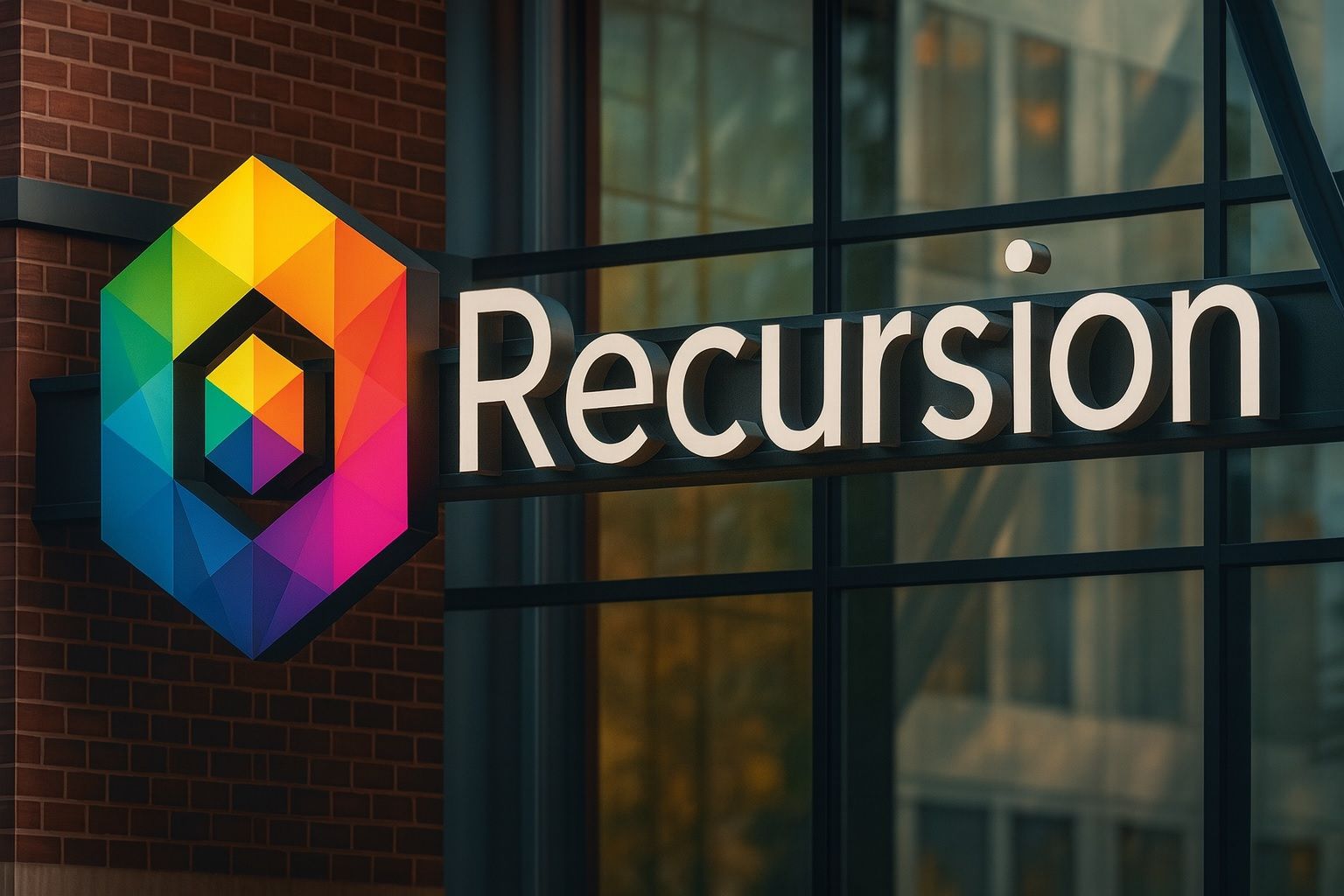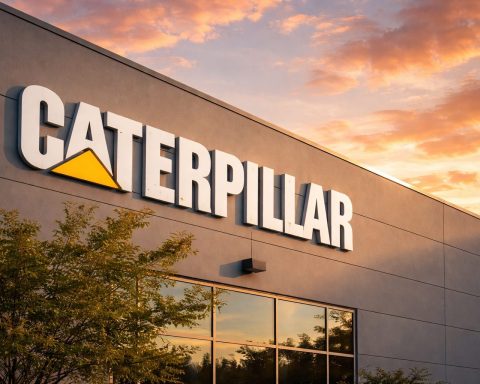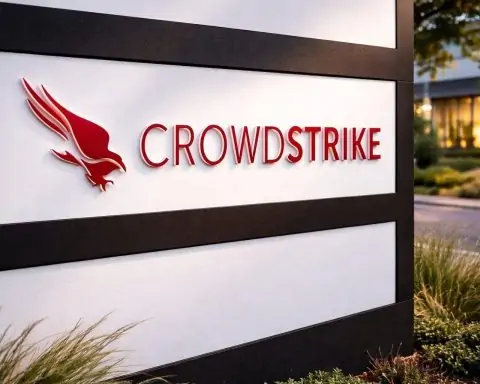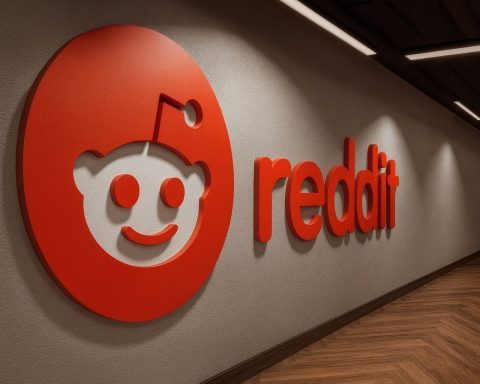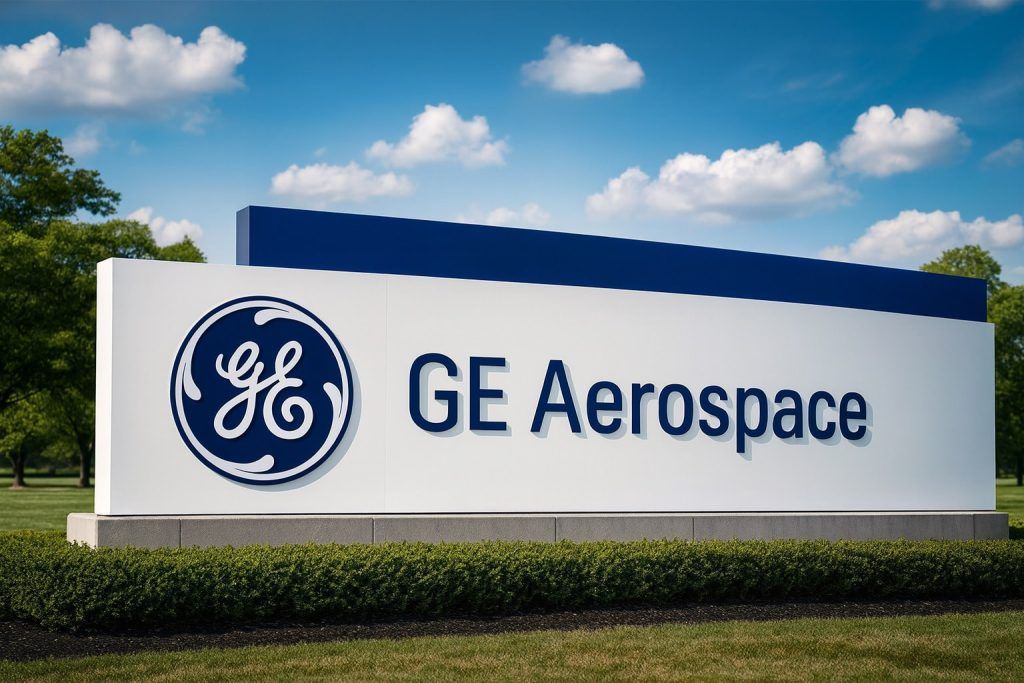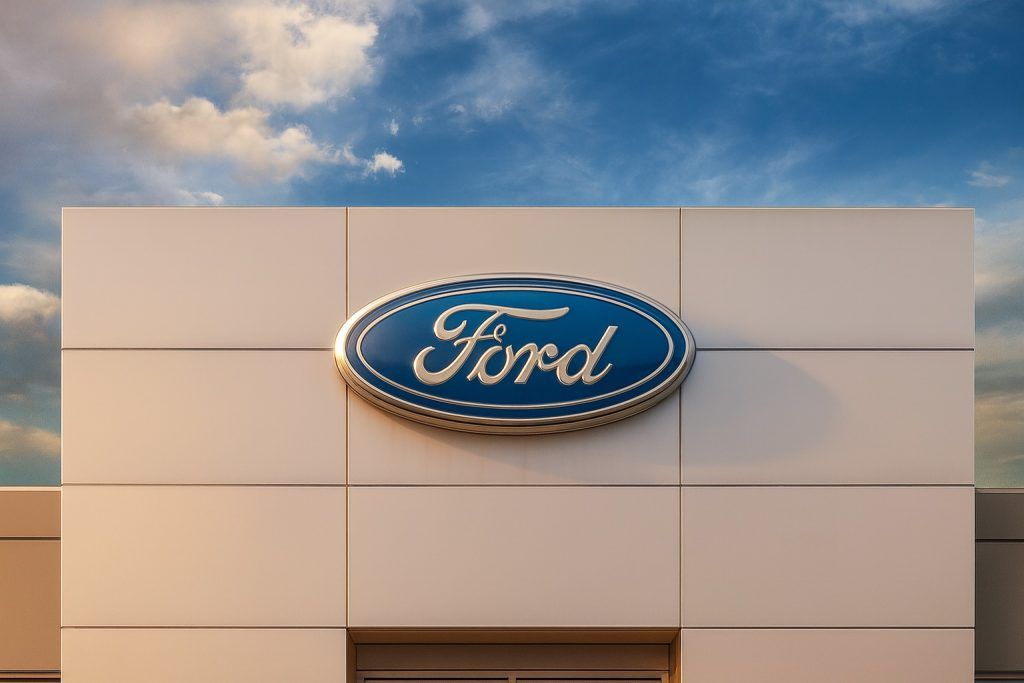- Current Price (Oct. 24, 2025): ~$6.04 (closing price) [1], roughly mid‐range of its volatile trading (52-week high ~$10.8, low ~$3.9) [2]. Recent trading saw dramatic swings – RXRX jumped ~16% intraday on Oct. 20 to ~$6.8 [3], recouping earlier October losses.
- Recent Performance: Over the past month the stock has run ~+44%, vastly outperforming biotech and broad markets [4]. Volume spiked amid this volatility (e.g. ~86.9 million shares traded Oct. 16, >200% above normal [5]). Technicals are mixed: the 50-day moving average (~$5.1) is still below the 200-day (~$5.8) [6].
- Financials (Q2 2025): Revenue $19.2M (+33% YoY) – boosted by a $7M milestone from Sanofi – but a net loss of $171.9M [7]. R&D spending surged (to ~$128M) as the company expanded its AI platform and integrated Exscientia [8]. Cash on hand was ~$534M at 6/30/25, funding operations into late 2027 [9] [10]. Management now expects 2025 cash burn < $450M after recent cost cuts [11].
- Pipeline & Partnerships: Recursion is a clinical-stage “TechBio” biotech using AI for drug discovery. Its pipeline focuses on oncology and rare diseases. Lead internal candidates include REC-1245 (an oral RBM39 degrader) and REC-617 (a CDK7 inhibitor), both in Phase 1/2 trials [12]. New assets were added via partnerships (e.g. REC-102, an ENPP1 inhibitor, and REC-4881, a MEK inhibitor for FAP) [13]. In Jan 2025, Recursion announced that the FDA cleared an IND for REC-4539 (a brain-penetrant LSD1 inhibitor for SCLC) and the UK’s MHRA cleared a trial of REC-3565 (a selective MALT1 inhibitor for blood cancers) [14]. Several late-stage readouts are expected by end-2025 (e.g. Phase 2 data for REC-617 and REC-4881 [15]).
- Partnerships & M&A: The company has struck deals with major pharma partners. Ongoing collaborations include Sanofi (multi-target oncology/immunology, >$130M received to date) [16], Roche/Genentech, Bayer, Takeda and Merck KGaA on various discovery projects [17] [18]. In late 2024 Recursion completed a ~$630M all-stock merger with UK AI-biotech Exscientia, boosting its AI capabilities and pipeline [19].
- AI & Tech Focus: Recursion brands itself a TechBio firm, leveraging its proprietary RecursionOS platform and AI models. Notably, Recursion co-developed the “Boltz-2” AI model (with MIT/NVIDIA) for ultrafast molecular screening (~1000× speed-up) [20]. Management frequently emphasizes the platform’s power: CEO Chris Gibson has said its platform “allows us to discover and develop potential new medicines… deploying advanced models like Boltz-2 to identify and optimize molecules” [21].
- Analyst Sentiment & Forecast: Wall Street is mixed. Roughly 2 analysts rate RXRX a Buy versus many Holds and some Sells [22]. The average 12-month price target is about $6.0 (implying only ~4% upside) [23], with a range from $3 to $8. Needham (Sept 2025) reiterated a Buy at $8, praising Recursion’s “leadership in AI-driven drug discovery” [24]. Others are more cautious: Morgan Stanley and Bank of America have “hold/neutral” views (Morgan $5 PT) [25]. Zacks ranks RXRX a Sell (citing continued losses) [26]. Even CNBC’s Jim Cramer recently quipped that Recursion has “done absolutely nothing” so far and must prove its AI platform with clinical success [27].
- Ownership & Sentiment: Institutional investors are heavily involved – one report lists ~89% of shares held by institutions [28]. Insider ownership is also significant. However, short interest is very high: ~126M shares are short, about 31% of the float (requiring ~1.8 days to cover) [29]. Insider selling has drawn attention: CEO Gibson offloaded 100K shares (~9.5% of his holdings) on Oct 10 at ~$6.04 ($~604K) [30], and again 100K shares on Oct 23 at $5.70 ($570K) [31]. Such sales – even if pre-planned – add to investor caution.
AI-Driven “TechBio” Strategy
Recursion’s narrative centers on its AI-enhanced drug discovery platform. Founded in 2013 in Salt Lake City, Recursion has spent years building RecursionOS, a giant database of cellular images and chemical data powered by machine learning [32]. The company invested heavily in bio-automation infrastructure (like its NVIDIA-based supercomputers) to train AI models on billions of data points. Its strategy is twofold: use this tech to generate proprietary drug candidates while partnering with pharma giants to co-develop new drugs. As one biotech newsletter notes, Recursion “has focused on fewer but more strategically important deals” with big pharma, securing hefty upfronts and milestones, while advancing its own pipeline in parallel [33]. The recent Exscientia merger and open-sourcing of the Boltz-2 model underscore its AI ambitions [34] [35].
During Q2’s business update, Recursion executives emphasized AI’s role. Co‑founder/CEO Chris Gibson said on the earnings call that the platform gives “insights on patient populations” and cited Boltz-2 as a key advantage [36]. The company notes that without any approved products, its value rests on being a “data and AI powerhouse” – a narrative the CEO and R&D chiefs continually highlight. Chief R&D Officer Najat Khan (also a big shareholder) has described how AI-designed compounds like REC-1245 and REC-617 came from machine-learning-driven biological maps. In press releases, Khan explains how these molecules were “precisely designed, powered by the Recursion OS platform,” potentially targeting diseases in ways older drugs could not [37] [38].
Pipeline and Collaborations
Recursion’s clinical pipeline is still early-stage, with no Phase 3 drugs yet. The focus is largely on oncology and genetic diseases. The lead programs – REC‑1245 (RBM39 degrader) and REC‑617 (CDK7 inhibitor) – are in Phase 1/2 and are now enrolling patients [39]. Management confirmed that early data from those trials have shown “strong activity in tumors” [40]. Other internal programs (e.g. REC-994 for a rare neurological disease) are in mid-stage. In 2025, Recursion has been streamlining its pipeline: several lower-priority Phase II programs were cut or shelved to focus resources on the most promising drugs [41].
Meanwhile, Recursion’s partner-funded pipeline continues to expand. Sanofi – a cornerstone partner – is working on multi-target cancer and immunology programs. Sanofi has already paid Recursion over $130M in upfronts/milestones and triggered a $7M payment in Q2 (its fourth discovery milestone) [42] [43]. Other deals include Roche/Genentech (neuroscience and GI oncology phenomics), Bayer (precision oncology against ‘undruggable’ targets) and Merck KGaA (immunology/cancer targets) [44]. These collaborations not only provide funding but also validate Recursion’s AI approach in the eyes of investors.
In regulatory news, Recursion is quietly advancing new INDs. Its Jan 2025 announcements revealed that the FDA cleared INDs for two new oncology assets: REC-4539, a brain-penetrant LSD1 inhibitor now heading to Phase 1/2 trials in small-cell lung cancer, and REC-3565, a novel MALT1 inhibitor for blood cancers (approved by the UK’s MHRA) [45]. These milestones flew under the radar of broad news coverage but bolster the idea that Recursion’s AI platform is yielding tangible drug candidates.
Financials and Operations
Recursion’s recent financial results reflect its high-growth, high-burn model. Q2 2025 revenue came in at $19.2M (33% higher than a year prior), helped by that Sanofi milestone, but net loss widened to $171.9M [46]. R&D expenses climbed sharply (to ~$129M) as the company built out its labs, AI infrastructure and integrated Exscientia. With no products on the market, Recursion relies entirely on investor and partner funding – hence the emphasis on “runway” and burn rate. At quarter-end it had about $534M in cash [47]. This is a hefty buffer but it is being spent quickly: the company had guided for 2025 burn around $606M before its mid-year cuts.
To preserve capital, Recursion announced in June 2025 that it would lay off ~20% of its 800-person workforce [48]. CEO Gibson told Reuters the cuts were aimed at “reducing complexity… so that every dollar drives real return on investment” [49]. Management projects that the restructuring will trim full-year 2025 cash burn to under $450M (and 2026 burn under $390M) [50], extending the cash runway into late 2027. Investors view this pragmatically: on one hand it shows cost discipline, but on the other hand it underscores that Recursion is not yet profitable and is heavily reliant on investor cash.
Stock Performance & Analyst Views
Recursion’s stock has been extremely volatile in October 2025. On Oct 7 it dipped to the mid-$5s, then bounced ~16% on Oct 8 (to ~$6.1) amid an AI industry conference where Gibson spoke [51]. Later in the month, after a modest pullback, RXRX surged ~16–18% on Oct 20 to an intraday ~$6.8 [52]. That rebound coincided with broad biotech rallies (peer names like Replimune and Celcuity also spiked on FDA news that day) [53]. By Oct 24 the stock traded around $6.0 [54], well below its 52-week peak (~$10.87) but far above the sub-$4 lows from late 2024.
Wall Street remains divided. Financial data aggregators show about 5 major analysts covering RXRX with 2 Buys and the rest Holds/Sells [55]. The average 12-month price target is only about $6.0–6.5, implying little upside from current levels [56]. Needham’s Gil Blum is an exception – he reiterated a Buy on Sept. 11 with an $8 target, highlighting Recursion’s leading AI platform and data set [57]. In contrast, Morgan Stanley initiated coverage as a Hold at $5 (new July 2025 report [58]) and Bank of America has also been neutral around $8. Notably, quantitative rankers like TipRanks and Zacks tilt bearish: TipRanks shows five analysts averaging only $5.95 [59], and Zacks just gave Recursion a “Sell” rank due to widening losses and downbeat earnings revisions. CNBC’s Jim Cramer even quipped on Oct. 22 that RXRX had “done absolutely nothing” to date, essentially labeling it a “meme stock” until clinical proof arrives [60].
Ownership and Sentiment
Investor positioning in Recursion is quite polarized. Hedge funds and institutional money have large stakes (one source shows ~89% ownership by institutions [61]). Conversely, short sellers have bet heavily against the stock: about 126.3 million shares were short as of mid-Oct (over 31% of the float) [62]. Such short interest suggests many investors are skeptical of Recursion’s lofty valuation (current market cap ~$2.6B) and the timeline to profitability. It also raises the risk of short squeezes if good news arrives.
Among insiders, the spotlight is on CEO Chris Gibson. Gibson recently executed planned trades under a 10b5-1 plan: on Oct 10 he sold 100K Class A shares at ~$6.04 [63], and on Oct 23 he sold another 100K at $5.70 [64]. Altogether these sales totaled ~$1.17M; Gibson still directly holds ~950K Class A shares [65] (over 20% of his previous direct stake). Likewise, COO/CFO Najat Khan sold 36.6K shares in August at ~$5.52 [66]. While these trades were pre-announced and only a small fraction of their total holdings, they have nonetheless fueled chatter about insider confidence. On the positive side, the company’s large cash stockpile and partnerships (with over $20B in potential milestones in partner contracts) give it ample funding to advance trials.
Outlook
Recursion’s near-term outlook revolves around biotech-drug milestones and how well its AI story holds up. Catalysts include upcoming data: late-2025 readouts from the Phase 2 trials of REC-617 (ovarian cancer) and REC-4881 (FAP) could validate the platform if positive [67]. Any new clinical advances or licensing deals (e.g. with Sanofi or others) could drive the stock, as would the next quarterly report (due Nov. 5) showing revenue growth or savings from cost cuts. Conversely, any setbacks in trials, further-than-expected losses, or unfavorable biotech policy shifts (e.g. in drug pricing) could pressure the shares.
Analysts and investors will closely watch whether Recursion can translate its “AI tech hype” into real medicines. As one market commentator put it, Recursion is a high-risk, high-reward play: “upside if AI-derived drugs deliver – and downside if the hype isn’t met with results” [68]. For now, the stock’s recent pop has reignited interest, but most experts caution it remains an ambitious bet on the future of AI-driven drug discovery.
Sources: Company filings and press releases [69] [70]; Reuters, GlobeNewswire, and MarketBeat reports [71] [72]; ts2.tech analyses [73] [74]; financial data providers (TipRanks/Finviz) [75] [76]; insider/analyst reports [77] [78], and other market commentary. All information is current as of Oct. 26, 2025.
References
1. finviz.com, 2. ts2.tech, 3. ts2.tech, 4. ts2.tech, 5. www.marketbeat.com, 6. ts2.tech, 7. ts2.tech, 8. ts2.tech, 9. ts2.tech, 10. www.reuters.com, 11. www.reuters.com, 12. ts2.tech, 13. ts2.tech, 14. www.globenewswire.com, 15. ts2.tech, 16. ts2.tech, 17. ts2.tech, 18. ts2.tech, 19. ts2.tech, 20. ts2.tech, 21. www.globenewswire.com, 22. ts2.tech, 23. www.tipranks.com, 24. ts2.tech, 25. ts2.tech, 26. ts2.tech, 27. ts2.tech, 28. www.marketbeat.com, 29. www.benzinga.com, 30. ts2.tech, 31. www.investing.com, 32. biotechhealthx.com, 33. biotechhealthx.com, 34. ts2.tech, 35. ts2.tech, 36. ts2.tech, 37. www.globenewswire.com, 38. ts2.tech, 39. ts2.tech, 40. ts2.tech, 41. ts2.tech, 42. ts2.tech, 43. ts2.tech, 44. ts2.tech, 45. www.globenewswire.com, 46. ts2.tech, 47. ts2.tech, 48. www.reuters.com, 49. www.reuters.com, 50. www.reuters.com, 51. ts2.tech, 52. ts2.tech, 53. ts2.tech, 54. finviz.com, 55. ts2.tech, 56. www.tipranks.com, 57. ts2.tech, 58. www.marketbeat.com, 59. www.tipranks.com, 60. ts2.tech, 61. www.marketbeat.com, 62. www.benzinga.com, 63. ts2.tech, 64. www.investing.com, 65. www.investing.com, 66. www.marketbeat.com, 67. ts2.tech, 68. ts2.tech, 69. www.globenewswire.com, 70. ts2.tech, 71. www.reuters.com, 72. www.marketbeat.com, 73. ts2.tech, 74. ts2.tech, 75. www.tipranks.com, 76. finviz.com, 77. www.marketbeat.com, 78. www.investing.com
